Environmental Impact of QR Codes: Statistics on Paper Savings
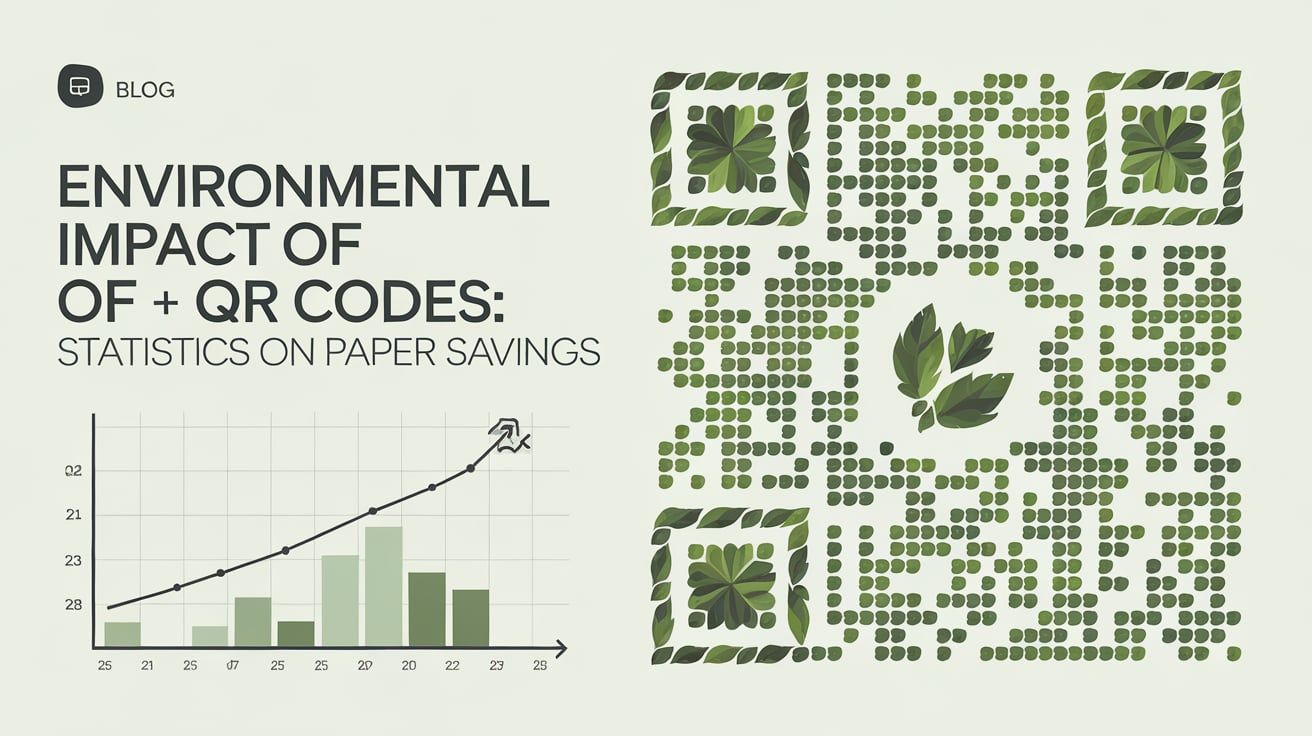
QR codes, short for Quick Response codes, are two-dimensional barcodes that can be scanned using a smartphone or QR code reader. Initially used in the automotive industry to track vehicle parts during manufacturing, QR codes have evolved and have found extensive application in various industries due to their ability to hold a large amount of data and easy scannability.
In the last few years, QR codes have made a significant mark in the realm of environmental sustainability. By their very design, QR codes reduce the need for physical materials like paper, as they connect users directly to digital platforms. This has led to a decrease in paper usage, thus contributing to deforestation reduction.
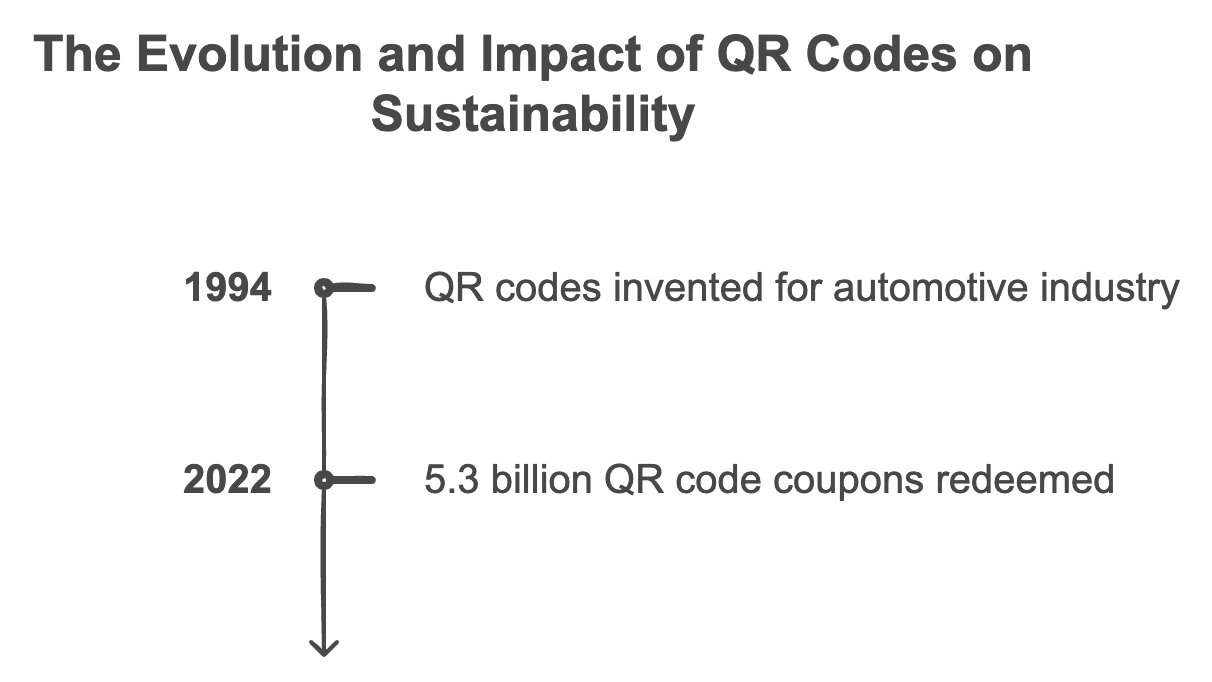
According to a report by Juniper Research, the number of QR code coupons redeemed via mobile will reach 5.3 billion by 2022. Given that traditional paper coupons would have been used otherwise, the implications of such paper savings are huge, leading to less strain on our forests and a reduction in the energy consumed during paper production.
In the next sections, we will delve into the specifics of how embracing QR codes leads to significant paper savings and explore real-world examples that highlight these benefits.
QR Codes and the Pressing Need for Paper Reduction
Using paper might seem harmless, but when we consider the sheer volume of paper produced worldwide, the environmental impact is substantial. Factoring in the energy and resources expended in its production and disposal, the repercussions are far from negligible.
According to The World Counts, we use about 80 billion trees every year for paper. This heavy reliance contributes to deforestation, loss of biodiversity, and increases in greenhouse gas emissions. But what if we could significantly cut this number down? This is where QR codes come into play.
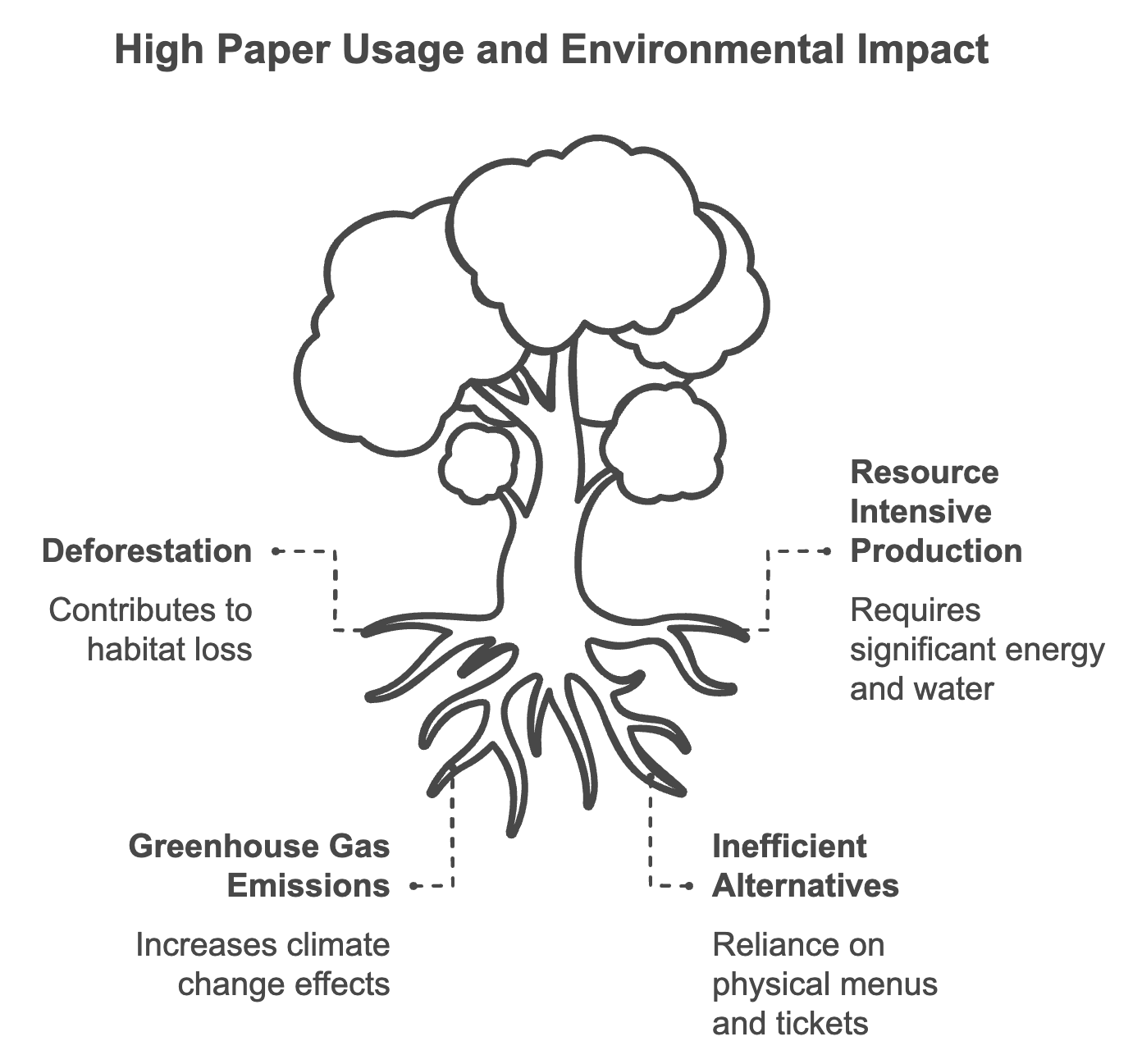
QR codes' digital nature means they inherently advocate for a reduction in paper waste. The use of QR codes in places like restaurants and cafes for menus or e-ticketing for transportation and events negates the need for physical paper copies, thereby reducing paper waste.
For instance, the move from paper menus to QR code menus in restaurants has resulted in potential savings of up to 80% in paper usage per restaurant annually.
Considering the number of restaurants globally, this equates to substantial savings in terms of both paper usage and the associated resources and energy used in its production and disposal.
In the next section, we will dive into these industries' case studies that have adopted QR codes, offering a more concrete view of the paper savings possible through this technology.
Case Studies on Paper Savings through QR Codes
Several industries have adopted QR codes, and they have reaped the benefits of not only improved operational efficiency but also significant paper savings. Let’s explore a few of these instances:
Case Study 1: Restaurant Chains
A notable case is Starbucks, which recently made a shift to digital menus through QR codes in an effort to boost its environmental sustainability agenda. With about 33,000 stores worldwide, imagine the amount of paper saved from not printing menus alone. The switch to digital menus vastly reduced paper use, contributed to waste reduction and decreased associated overhead costs.
Case Study 2: Airlines
The airline industry is another sector where QR codes have significantly helped to reduce paper waste. We’ve all seen the shift from paper boarding passes to e-tickets with QR codes. In 2019, Scandinavian Airlines reported that 90% of their passengers were using digital boarding passes. This drastic decrease in paper-based tickets has allowed airlines to save significant amounts of paper in boarding passes, thereby reducing their environmental footprints.
Case Study 3: Logistics and Supply Chain Management
In logistics, QR codes have revolutionized the way product tracking and inventory management are tackled. QR-based labelling versus paper-based labelling and documentation streamlines the process, thereby generating less paper waste. For instance, DHL, the international courier, parcel, and express mail service, uses QR codes for its e-commerce solutions. They use them on shipping labels for easier tracking, further eliminating excessive paper printouts.
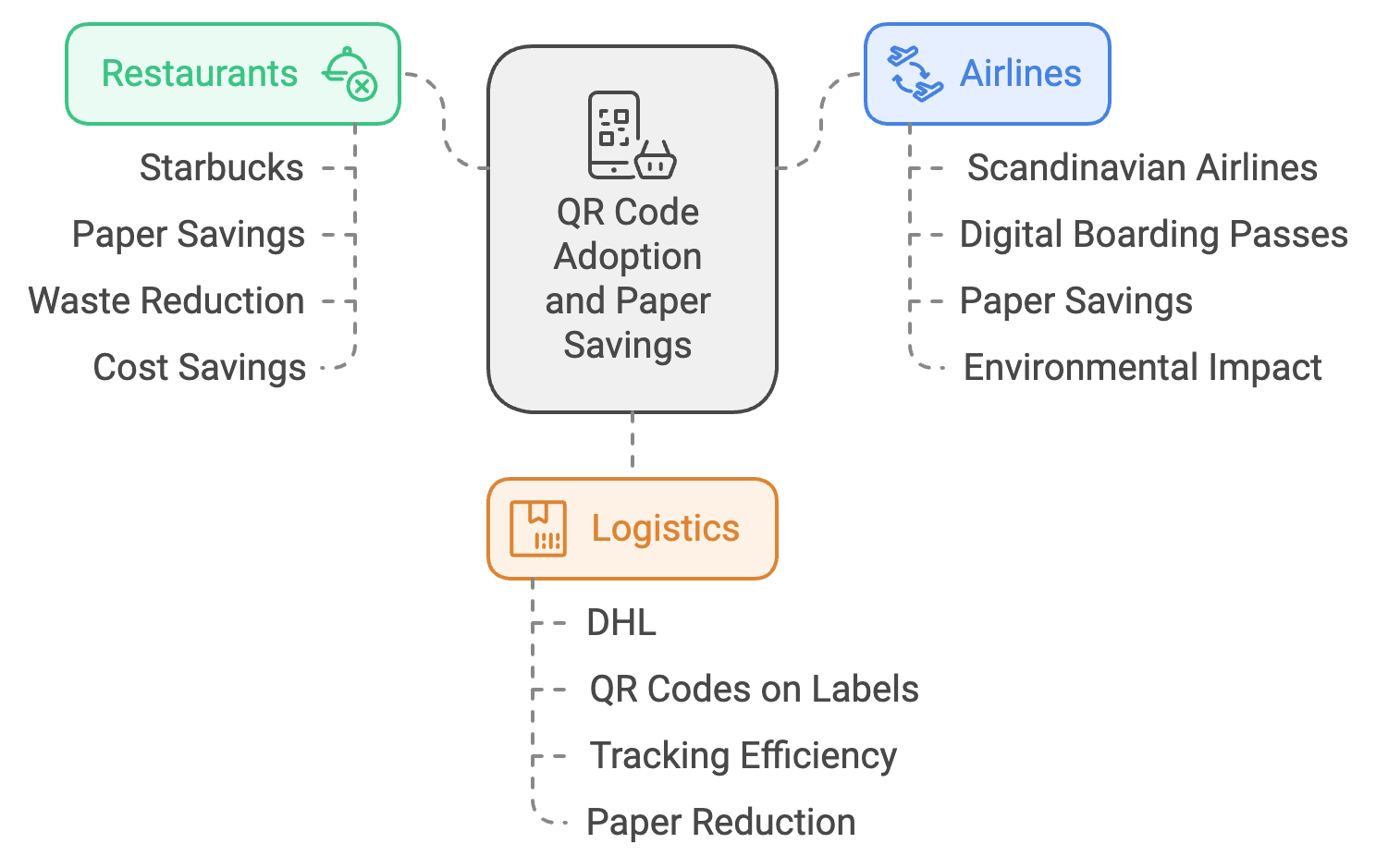
These are just a few examples that illustrate the paper-saving potential that QR codes offer across different industries. The ripple effect of this reduction in paper utilization has wide-reaching environmental benefits, as discussed in the next section.
Impact of Paper Reduction on Forest Conservation
With every ton of paper saved, we are effectively contributing to the conservation of our forests. Trees absorb carbon dioxide during photosynthesis, playing a crucial role in combating climate change. According to the U.S. Environmental Protection Agency (EPA), one mature tree can absorb up to 48 pounds of carbon dioxide per year. Considering the reduction in paper usage due to QR codes, it's clear that this technological shift has considerable secondary environmental benefits.
Beyond just forest conservation and reduced greenhouse gas emissions, the ripple effects also extend to energy conservation. According to the University of Southern Indiana, "recycling half the world’s paper would free 20 million acres of forest land". Furthermore, "recycling one ton of paper saves around 682.5 gallons of oil, 26,500 liters of water and 17 trees". The energy used in the production, transportation, and disposal of these saved resources underscores the impact QR codes have beyond just paper savings.
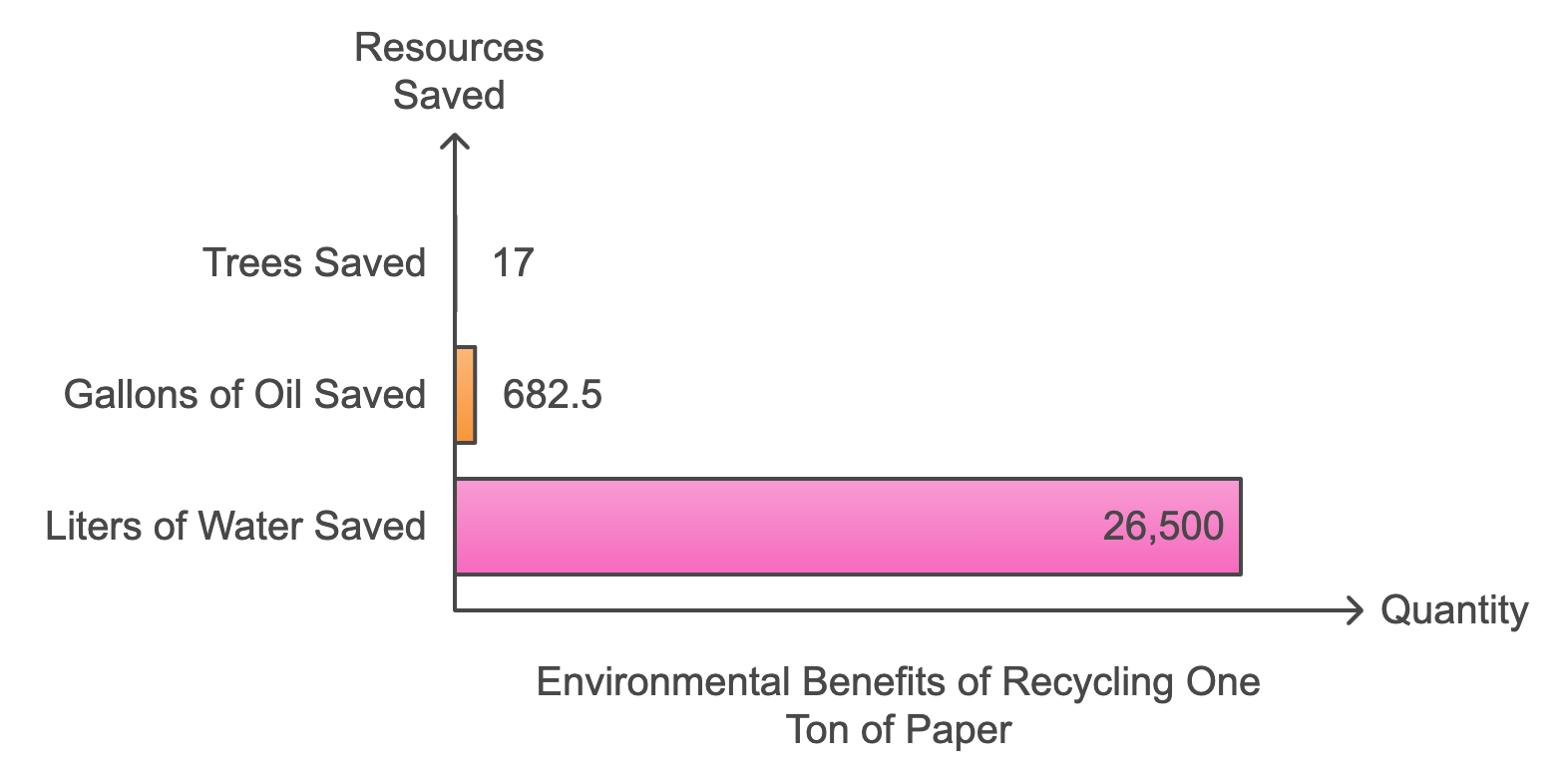
In the upcoming section, we examine the statistics and data on the shift in consumer behaviors toward preferring QR codes, further solidifying their viability as a resource-saving solution.
Consumer Response to QR Codes
The transition toward QR codes isn't just industry-driven. Consumers, too, have embraced QR codes wholeheartedly. Considering the convenience, hygiene, and safety, particularly during the COVID-19 era’s touchless necessity, users find QR codes to be an agreeable solution.
According to a 2021 consumer survey, around 84% of respondents have scanned a QR code, with 32% doing so at least once a week. More importantly, for our topic, 36% of respondents said they prefer businesses to use QR codes for environmental reasons.
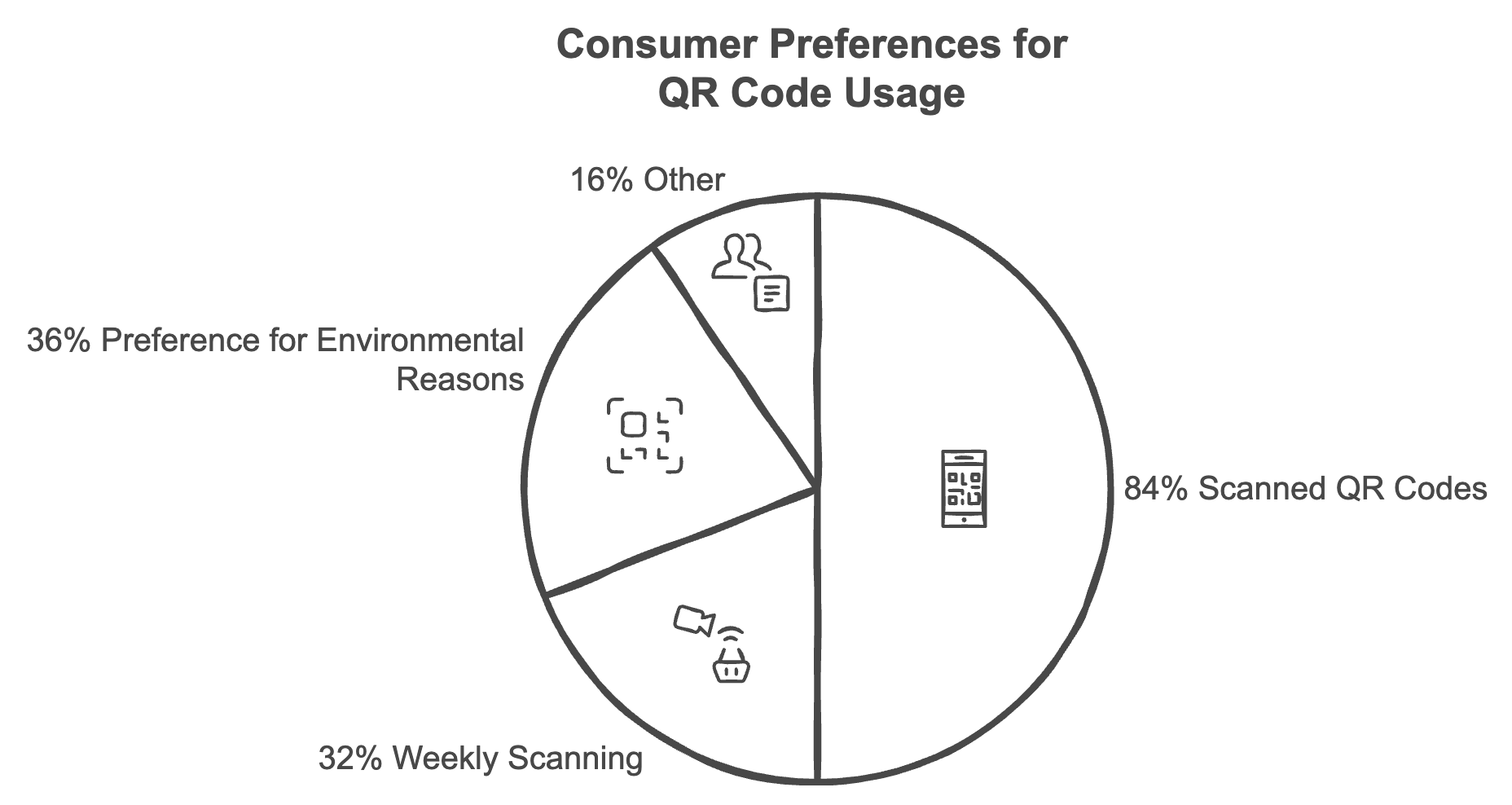
Such data signify a shift in preferences that aligns with the sustainability goals of reducing paper usage. From paperless invoice to digital tickets, QR codes have revolutionized sectors and reduced their dependence on paper.
Case Study: Event Ticketing
Consider the case of event ticketing. QR coded e-tickets have become an industry standard, from concerts to airline boarding passes. Ticketmaster, in one of their articles, mentions that in 2018, "close to half (46%) of UK festival-goers ages 18-24 favor using a mobile phone as a ticket to attend a live event" and that they have seen a "25% increase in mobile ticket sales on last year".
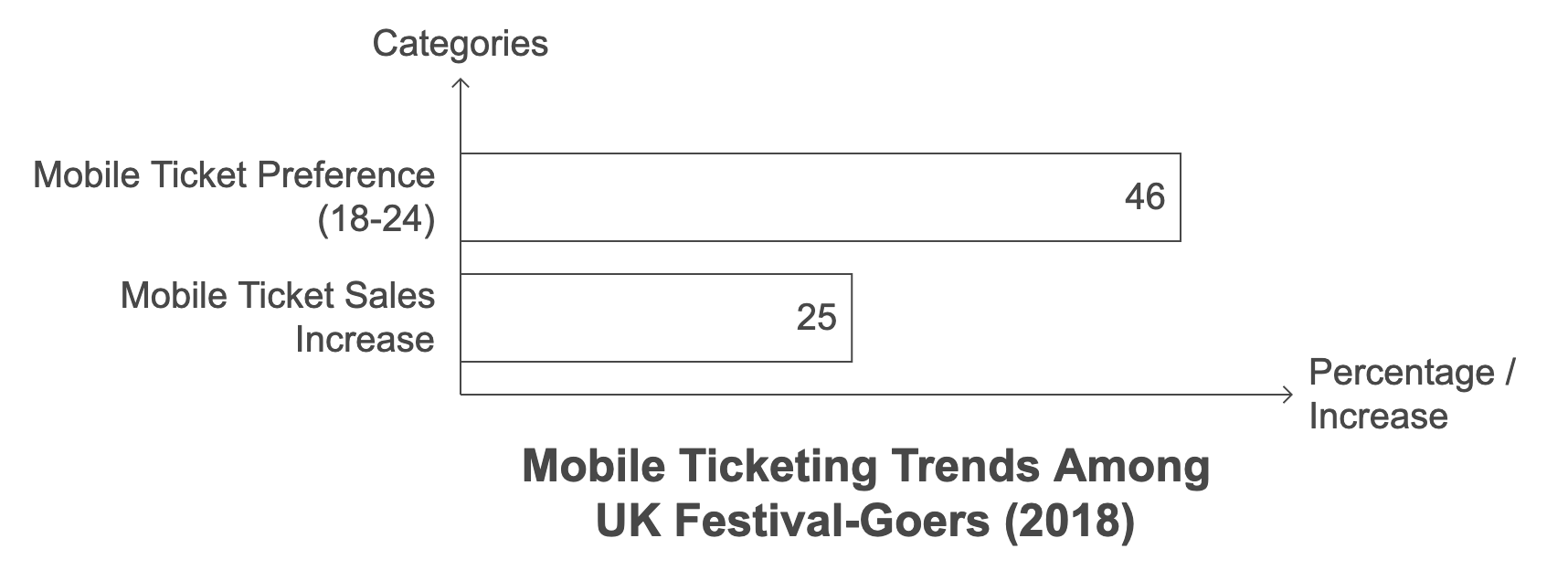
This represents a significant drop in paper ticket usage, leading to considerable paper savings. The secondary effect, in this case, is the overall reduced environmental impact owing to the energy and resources required for printing, shipping, and disposing of millions of paper tickets.
As we have seen, the influence of QR codes on paper reduction and environmental impact is undeniably significant. However, studying the impact doesn't stop here. In the next section, we discuss how QR Code usage contributes to carbon footprint reduction.
Carbon Footprint Reduction through QR Codes
You might think of a carbon footprint as primarily associated with energy consumption or transportation emissions. Still, several less overt actions, like paper production, also contribute significantly to the carbon emissions tally.
According to the Energy Information Administration (EIA), paper production involves chemical processes that emit carbon dioxide. Quantity of CO2 emissions per short ton of production can be nearly 1,057 kg for pulp and paper industrial processes. Hence, when we talk about reducing paper usage through QR codes, we are also indirectly talking about reducing carbon emissions.
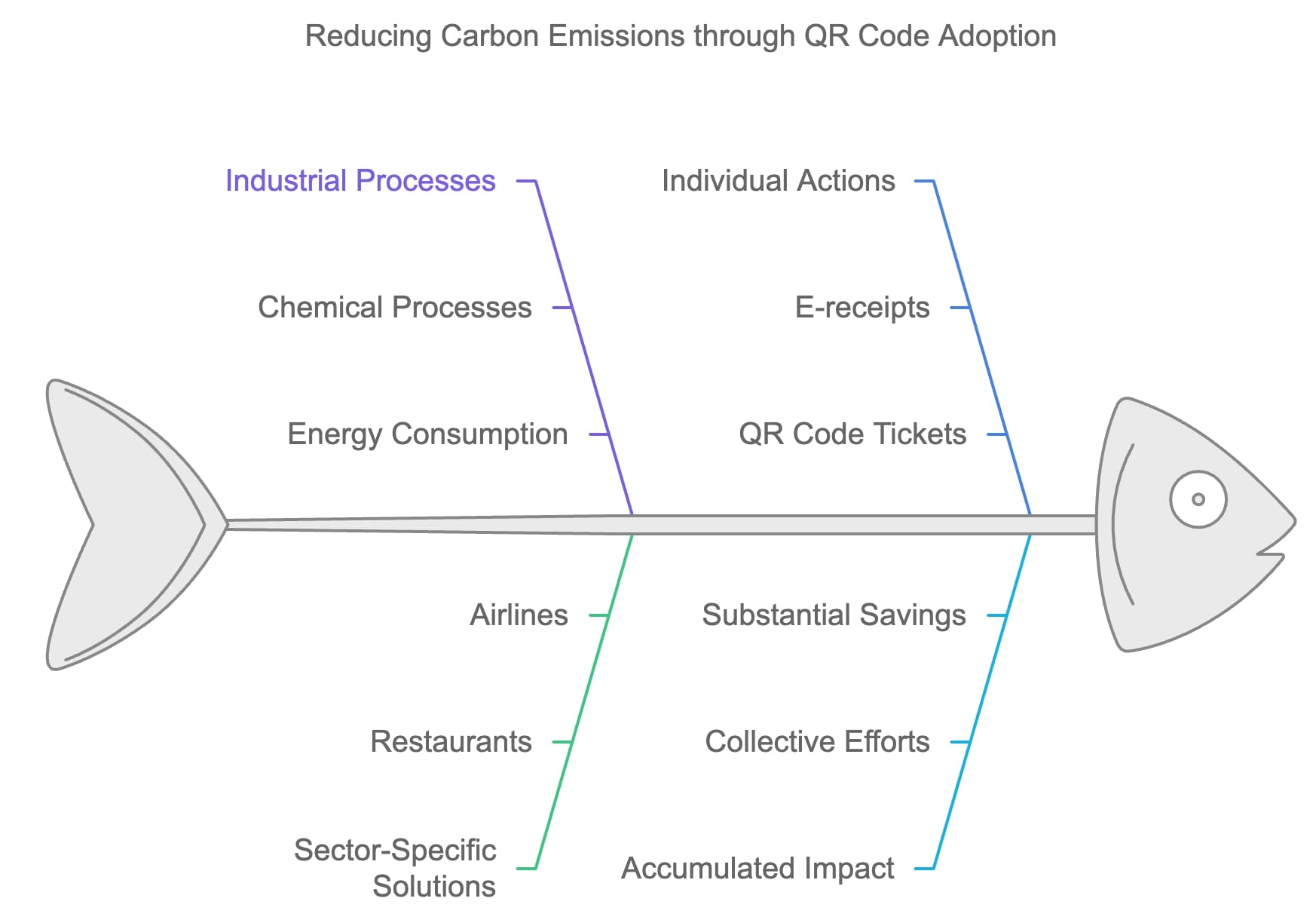
As we saw before, sectors like restaurants, airlines, and logistics have made significant strides in opting for QR codes which directly translate to reduced paper usage and in turn lower carbon emissions.
The QR code approach's beauty is that the efforts are not restricted to industries or businesses; even individuals, by opting for QR codes in their daily lives, can contribute to these savings. For instance, consider opting for e-receipts with QR codes instead of paper receipts for your shopping or using QR coded tickets for movies or events. While these may seem like small changes, accumulated over millions of people, the impact can be substantial.
Future Potential of QR Codes in Environmental Sustainability
As we become increasingly digital, the use of QR codes will only grow. They have already proven their worth in environmental sustainability by reducing paper usage and, as a result, reducing carbon footprints. Given the increasing public consciousness about environmental challenges and a global commitment to moving toward more sustainable practices, QR codes will play a significant role.
Report Projections
According to a report by Markets and Markets, the global QR code market is expected to grow from a $1.15 billion industry in 2020 to a 3.12 billion dollar industry by 2026. This growth projection is promising and highlights that the trend of using QR codes isn't just a passing phenomenon; it is here to stay and grow.
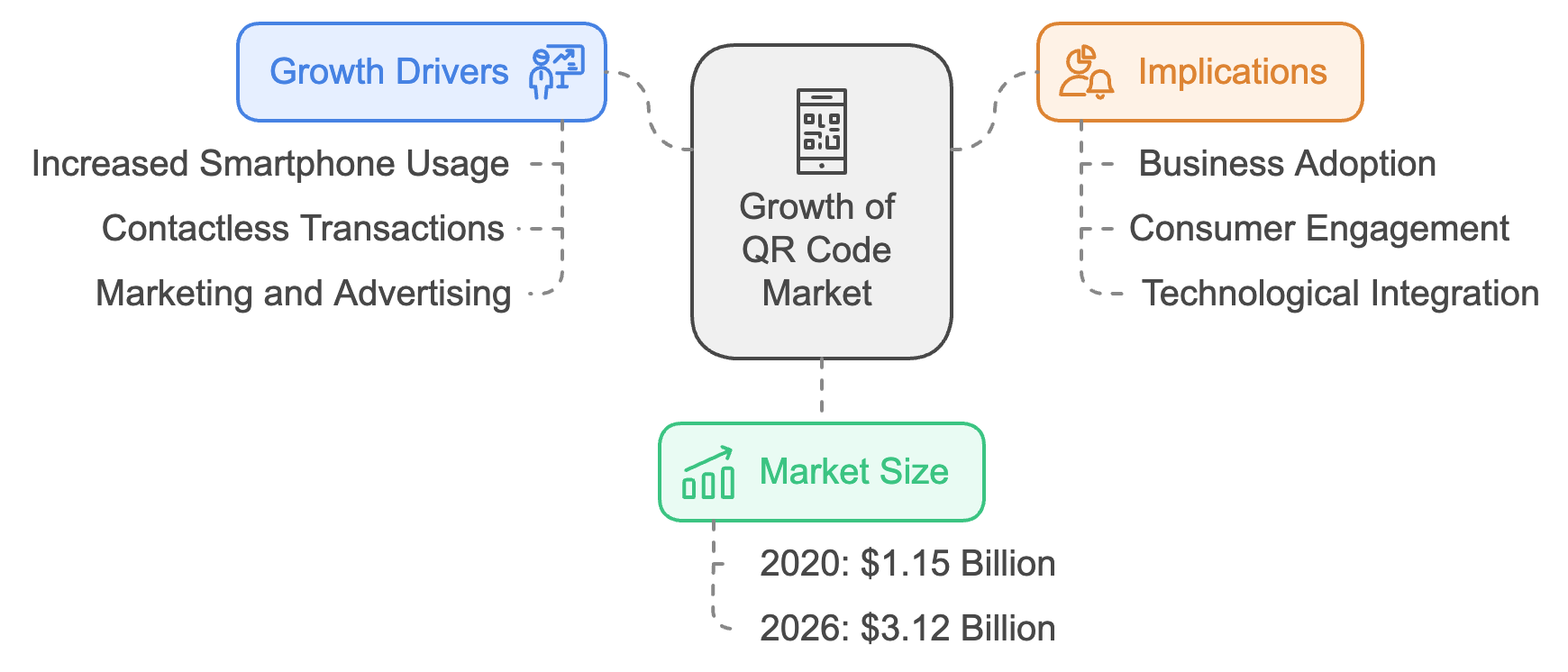
QR Codes and Education
One potential future use of QR codes in promoting sustainability could be in the field of education. In the future, we might see textbooks with QR codes printed on pages, referring students to additional resources, tests, and interactive content, thereby reducing the need for supplementary books and paper materials.
QR Codes and Smart Cities
QR codes also have the potential to become integral elements of future smart cities, promoting sustainability. Projections indicate increased usage in public transportation systems, city information portals, smart homes, and more, resulting in more paperless exchanges and reduced waste.
All these potential future implications of QR codes point towards a more eco-friendly and sustainable world.
In conclusion, from what we've discussed in this post and understood from the data and statistics, it is clear that the transition to QR codes is beneficial for the environment. Despite being a small change in our habits and processes, the impact is significant. Not only in terms of the tangible paper savings, but also in contributing to the larger goals of reducing our carbon footprint and promoting sustainability.
Conclusion: QR Codes - The Digital Bridge to Sustainability
From the day they were invented to streamline vehicle manufacturing in Japan, QR codes have come a long way. Today, they're much more than a tool for convenience. They've become critical allies in our constant battle against environmental issues. They're silent warriors, marking the intersection between technology and ecology, nudging us towards a greener planet - one scan at a time.
Given their impact on paper savings and associated energy and carbon emission reductions, embracing QR Codes more widely can pave the way for notable environmental gains. The journey towards sustainability can sometimes seem overwhelmingly complicated. Still, as our exploration of QR codes has shown, sometimes the solutions can be strikingly simple.
Next Step Call-to-Action: Want to take a step towards sustainability? Check out QRCode.co.uk and learn how you can integrate QR codes into your personal life or business. Scan the journey towards sustainability now!
Frequently Asked Questions
1. What is a QR Code?
A QR code (Quick Response code) is a type of barcode that can be scanned using a smartphone or QR code reader. These codes can link directly to text, emails, websites, phone numbers, and more!
2. How do QR codes save paper?
QR codes can replace many traditional uses of paper. For example, digital menus in restaurants, e-tickets for transportation and events, and e-receipts in retail can all be facilitated through QR codes.
3. How does reducing paper usage help the environment?
Reducing paper usage helps the environment in several ways. It reduces deforestation, saves water and energy used in paper production, decreases waste, and lowers greenhouse gas emissions.
4. How prevalent is the use of QR codes today?
QR codes have seen significant adoption globally across many sectors including the hospitality, transportation, retail, logistics and education industries. With advancements in technology and an increased focus on sustainability, their usage is becoming more and more common.
5. How do QR codes contribute to carbon footprint reduction?
The reduction in paper production due to QR codes means lower energy consumption, which results in less burning of fossil fuels and hence fewer greenhouse gas emissions.
6. What other benefits do QR codes present?
QR codes are versatile and convenient. They can hold a large amount of data and easily connect users to digital media and platforms. This has implications for improved customer experience, advertising, and accessibility, beyond just environmental benefits.
7. How can I start using QR codes?
Many free online QR code generators can help you generate QR codes for various needs. One such service is QRCode.co.uk, mentioned previously in our article. You can use these tools to create QR codes linking to your business website, digital menu, event ticket and more.
United Kingdom QR Code Usage Trends 2024

